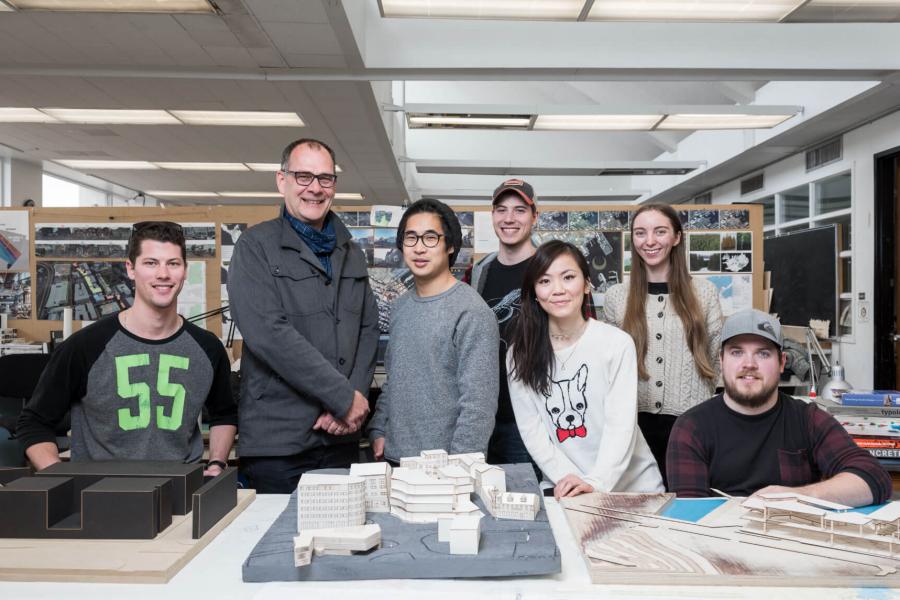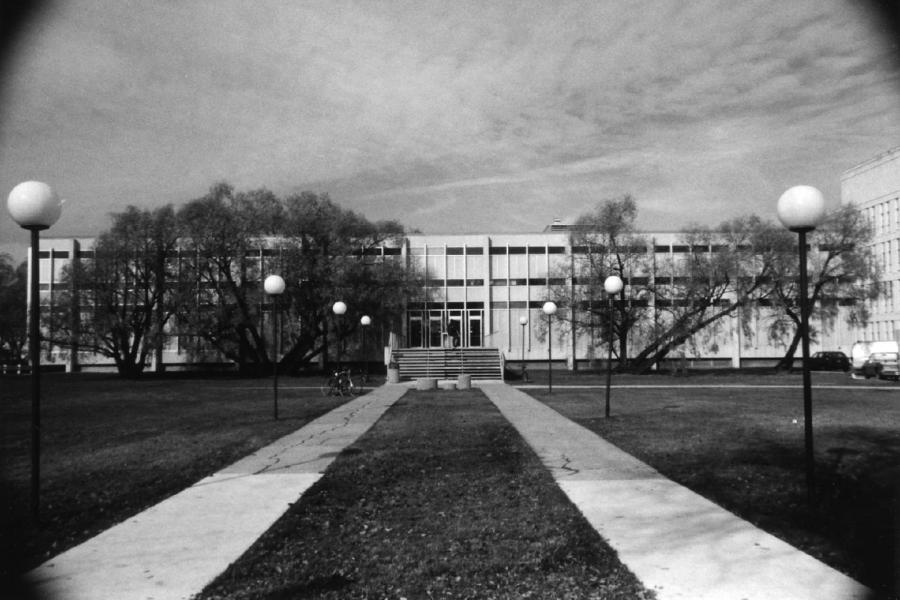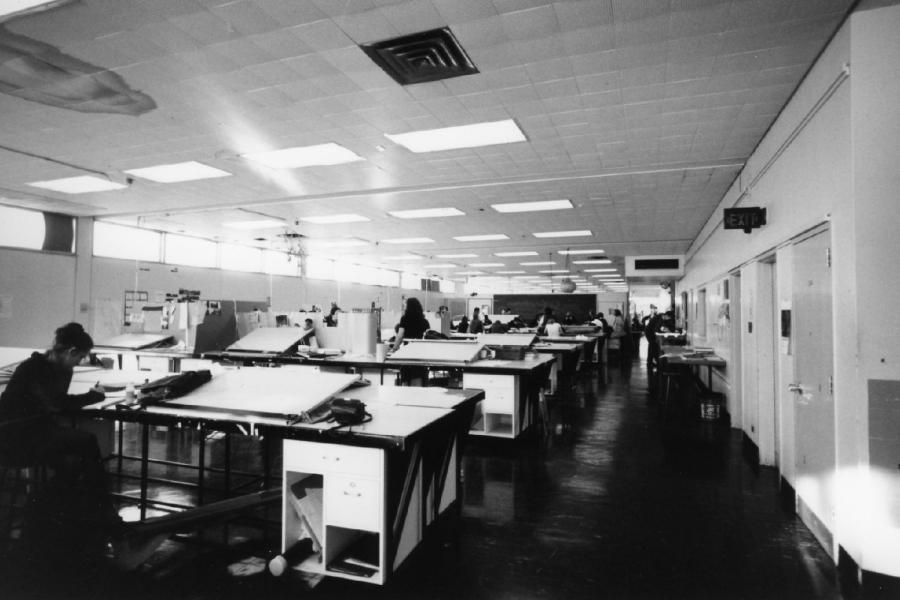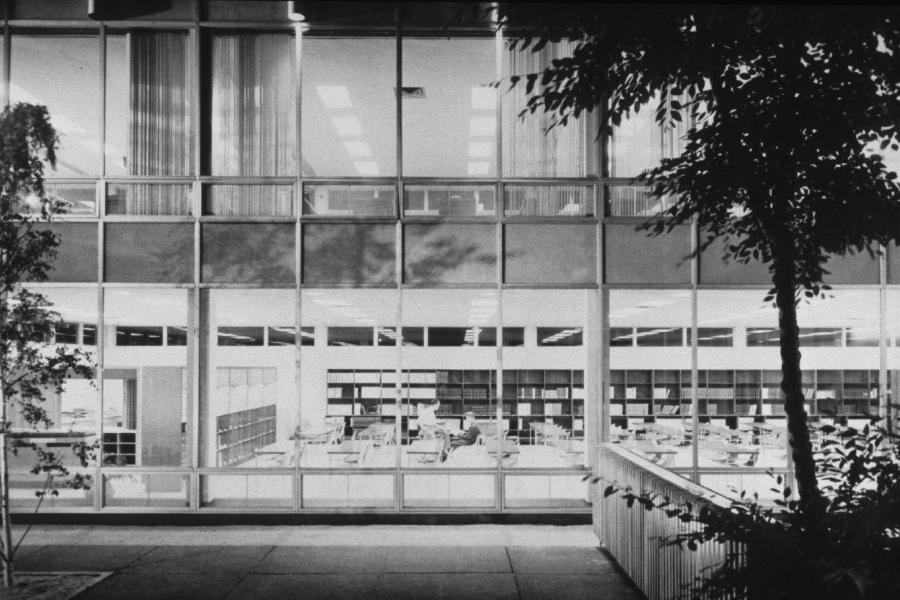The University of Manitoba's Faculty of Architecture is committed to creating an environment that delivers an exceptional experience in teaching, scholarship, and community service.
Office of the dean
With the support of department heads and associate deans, the dean's office is responsible for guiding the overall administration and strategic direction of the Faculty of Architecture.
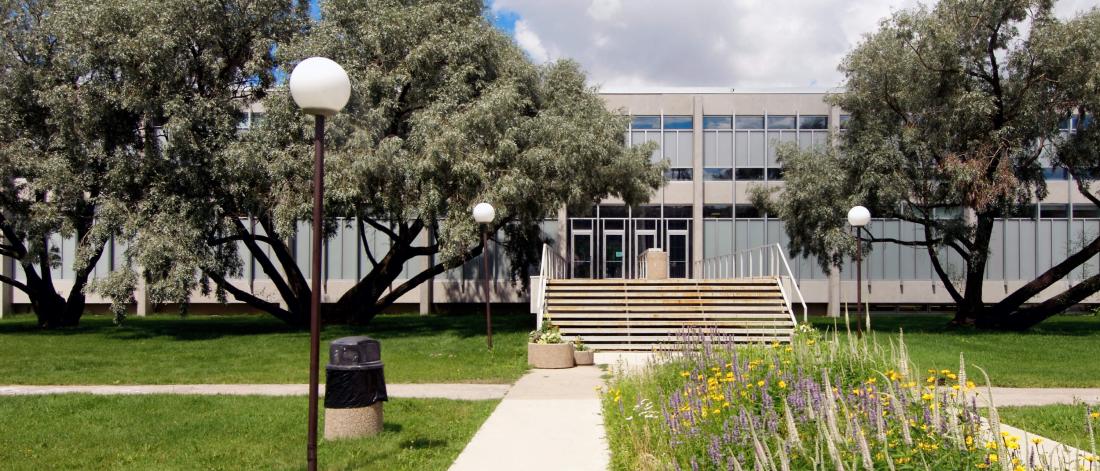
Our vision
The Faculty of Architecture aspires to offer widely recognized and highly valued design and planning undergraduate and graduate programs that promote a respectful, collegial, interdisciplinary culture of teaching, scholarship and service within the University and beyond.
Our mission
We aspire to provide exceptional teaching, scholarship and community service in architecture, city planning, environmental design, interior design, landscape architecture and emerging areas of design education and practice.
Our tenets
- The Faculty believes the disciplines and programs represented in the Faculty of Architecture are autonomous, complementary, equal and specific.
- The Faculty supports innovation and rigour in knowledge creation and creative problem solving in an intellectually and culturally diverse environment.
- The Faculty promotes collegiality, creativity, and interdisciplinarity in advancing the planning, design and management of the built and natural environments.
- The Faculty encourages advancement and improvement in the culture of planning and design through collaboration internally and externally.
- The Faculty champions an evolving, vibrant curriculum that is regularly evaluated and widely discussed.
- The Faculty offers locally, nationally and globally recognized programs which attract high quality students, expertise and funding.
- The Faculty promotes freedom of expression, open discourse and accountability among its members.
- The Faculty affirms an equitable assignment of teaching, scholarship and service that respects individual skills, interests and collective needs.
- The Faculty encourages and recognizes contributions from partnerships with the professions and community in the development and dissemination of knowledge.
- The Faculty fosters the development of an ethical and professional environment.
Our strategic plan
History of the Faculty of Architecture
The teaching of architecture began in 1913 as a four-year degree program within the Faculty of Arts. In 1920, the program became a part of the newly established Faculty of Engineering and Architecture. In 1938, a three-year diploma program in interior decoration was established. In 1945, the departments of Architecture and Interior Decoration were combined in the School of Architecture and Fine Arts. In 1948, the entire school was reorganized as the School of Architecture. The professional architecture degree became a five-year program; and a new four-year Bachelor of Interior Design degree was also introduced. In 1949, a one-year graduate program in Community Planning was established. In 1957, the Manitoba Legislature approved a grant for the construction of a building for the School of Architecture, the first in Canada to be designed exclusively for architecture education. In 1963, the school was reconstituted as the Faculty of Architecture and a two-year graduate program leading to the degree, Masters of City Planning, was introduced.
History of the Environmental Design Program
In 1966, the curriculum in Architecture was reorganized so that the degree, Bachelor of Environmental Studies, became the prerequisite for the professional programs in Architecture and Landscape Architecture. This was followed in 1970 with a new curriculum leading to the professional degree, Masters of Architecture, and two years later with new curriculum leading to a Masters of Landscape Architecture. In 1990, an admissions year of 30 credit hours of Arts and Sciences courses became a prerequisite for entry into Environmental Design.
In 1998, the Bachelor of Environmental Design (B.Env.D.) became an undergraduate program consisting of two years of shared design studies followed by a third year in one of the 'professional options'. These options included Architecture, City Planning, Interior Design, and Landscape Architecture. University 1 was introduced as a prerequisite for admission to the Environmental Design Program. In 2006, the Faculty of Architecture began to reform the Environmental Design Program to create a four-year undergraduate design program by including University 1 in its curriculum offerings. In 2007 the Faculty of Architecture introduced a four year design program consisting of two years of common 'Foundation Studies' (ED1/U1 and ED2) followed by two years of pre-professional 'Intermediate Studies' years (ED3 and ED4). The third and fourth years are referred to as the 'Option Years' and include Architecture, Interior Environments and Landscape + Urbanism (a shared option between City Planning and Landscape Architecture).
The B.Env.D. program is envisioned as a strong multidisciplinary undergraduate degree in its own right and provides a solid base of design education for students intending to pursue careers and/or graduate studies in a wide variety of disciplines, including the Faculty's masters degrees in Architecture, City Planning, Interior Design and Landscape Architecture, and at other institutions globally.
History of the Department of Architecture
The Department of Architecture offers a program of studies directed towards a fully accredited professional Master of Architecture degree.
People, place and passion make our architectural program unique, imaginative and real. Our urban-prairie setting is Canada’s central crucible of creativity and cultural complexity, offering fertile grounds for work that is as artistically ambitious as it is socially and environmentally responsible. Our faculty and students are dedicated to advancing the discipline, and everyone shares a passion for hands-on making and research.
We explore, discover and learn through making.
The core of our curriculum is the design studio. This is the place where thinking and doing converge in heuristic acts of making and world-making. In studio, students work through a variety of challenging questions, media and scales to explore vital tensions between technical and natural processes, cultural and artistic practices, experiential qualities and worldly phenomena. Design studio enables individuals to experiment widely, while ultimately making responsible design decisions for local situations in a dynamically interconnected world.
Studios are augmented by a growing array of making and thinking facilities: a FABLab, CADLab, Workshop, Architecture/Fine Arts Library, and Centre for Architectural Structures and Technology (C.A.S.T). Architecture students benefit from interactions with colleagues in our Faculty’s kindred disciplines (Environmental Design, Interior Design, Landscape Architecture and City Planning) and across the University. Students design everything from adaptable furniture to sustainable cities, from enduring buildings to transformative events. In the process we learn how the built environment not only supports and enhances lived experience, but is also meaningfully shaped by personal and collective imagination.
Architecture students in our program are fueled by their own expanding curiosities and convictions, guided and challenged by professors engaged in diverse research, and invigorated by conversations and collaborations with professionals, industry partners, community members, and international leaders in architecture and design.
Most graduates gain employment in the field, and pursue a path toward professional registration and careers as practicing architects. Other graduates continue with advanced post-professional studies and research, and/or thrive in careers in the arts, public service, the construction industry, and related design fields. The program produces capable graduates eager to contribute to improving the built environment and the public good.
History of the Department of City Planning
Our passionate and energetic core faculty of six runs a fully accredited program, together with dedicated professional practitioners, sessional instructors and adjunct professors. We contribute to key planning debates and professional practice on multiple fronts -- participatory planning and design, homelessness and housing, urban revitalization, arts and culture, social justice issues, environmental sustainability, regional planning issues, transportation planning and infrastructure, age-friendly and child-friendly planning and design, and Indigenous planning and governance.
Our unique program focuses on studio-based, hands-on, experiential learning. Throughout the two-year program, students work with governmental, non-profit and Indigenous clients to address real-life planning issues. Studio work is complemented by courses on planning theory, research methods and professional practice, as well as a recommended summer internship to gain professional experience. Students also have the opportunity to take electives outside the Faculty, (e.g., in Geography, Natural Resources, or elsewhere) depending on their interests.
As Manitoba’s capital city, Winnipeg is an exciting place to study planning, and our Department draws on considerable expertise throughout the region. Our faculty members maintain close links to professional practitioners in Winnipeg, throughout Manitoba and across the country. Students have the opportunity to interact with the planning community and the Manitoba Professional Planners Institute (MPPI) through our mentorship programs and speaker series. We also cooperate with Brandon University's Rural Development Institute.
The program prepares students for work in a variety of planning fields. We aim to strengthen the capacity of planning to enhance the ecological sustainability, social equity and aesthetic qualities of human settlements. The Master of City Planning (MCP) degree is accredited by the Professional Standards Board. Graduates are eligible for full membership status in the Canadian Institute of Planners (CIP) after gaining relevant professional experience. Our program has an excellent placement record, with the majority of graduates finding rewarding work in the field within three months of graduation.
A Brief History
Established in 1949 as part of the national initiative to develop capabilities in planning and development in post-war Canada, the Department of City Planning at the University of Manitoba offers the oldest continuing planning program in the country, and one of the oldest in North America. We are housed within the Faculty of Architecture. In its early years, the program concentrated on physical planning, reflecting both the nature of planning at the time and the design work of its founding director, Joseph Kostka. John Page (who joined the Department in 1965), Basil Rotoff (joined 1967), Mario Carvalho (1968), Hidehiko Tanimura (1968), and Dimitrios Syliaras (1973) all contributed to the intellectual growth of the Department. The Department’s activist and ethical stance was nurtured under Kent Gerecke’s headship starting in 1975. Earl Levin headed the Department in the early 1980s, with Geoffrey Bargh assuming the headship in 1986, and Christine McKee became head in 1991. The 1990s represented a period of renewal, with Ian Wight (1994), Ian Skelton (1996) and Sheri Blake (1997) joining the Department, as did Rae Bridgman and David van Vliet (both in 1998). They continued to build the Department’s legacy of social justice and environmental sustainability. During his time as Dean of the Faculty of Architecture (2001-2009), David Witty was also a member of the Department.
The Department continues to flourish under the leadership of Orly Linovski, whose research and teaching focus on the social and political production of urban space. Orly joined the Department in 2015 and assumed the headship in 2025. Richard Milgrom joined the Department in 2005 and served as head from 2009 until 2025. Janice Barry joined in 2013, Sarah Cooper in 2018, and Raphael Ayambire in 2022. The most recent member of the Department, Sarah Hourie, joined in 2025.
Over the years, the Department has consistently reached out to local communities to address timely and urgent planning issues. Our alumni live and work from coast-to-coast and around the world.
History of the Department of Interior Design
Interior Design is uniquely placed in the Faculty of Architecture with professional masters programs in Landscape Architecture, City Planning and Architecture. The interdisciplinary nature of the Faculty offers excellent opportunities for extending collaborative perspectives and theoretical understanding.
The Professional Master Degree Program aims to graduate Interior Designers equipped to work nationally and internationally at the forefront of their profession, with a skill set that includes strategic thinking, a research orientation and an ethical and environmentally responsible frame of reference. The program focuses on Design Studio with the Technologies, History and Theory, and Research integrated through Design projects. The Masters requires two years of study for students holding a Bachelor of Environmental Design or a similar Design degree. Students holding a University Degree from a non-design related discipline would be required to successfully complete a pre-master year before applying.
The Post Professional Master of Interior Design is also available for individuals wishing to pursue a self-directed research program. The program is an opportunity for in-depth research based on a foundation of Design Inquiry Methods and may take the form of a written thesis or project.
Areas of expertise in the Faculty include Universal Access, Design Education, Lighting, Work Environments, Human Comfort and Profession-based Research.
Interior Designers have an established reputation for successful collaboration in the building industry—they work independently or in conjunction with a design team to determine the interior environments; assessing and interpreting client and user requirements for projects as diverse as hospitals, offices, restaurants, retail design, and resorts.
History
The Interior Design Department at the University of Manitoba has a long established reputation for excellence and leads Canada in the development of the first Professional Masters degree in Interior Design. It has been a FIDER accredited program since 1974.
Mission
The Department of Interior Design, situated within an interdisciplinary design faculty, distinguishes itself through the excellence and creativity of its graduate program as well as its commitment to the advancement of the discipline and practice of interior design.
Goals
The aims of the Department of Interior Design are to educate students in solving complex design problems and prepare graduates for leadership roles in the design profession.
Values
The department of interior design values social, ethical and environmental responsibility, research-based outcomes; and critical thinking.
Revised: Mission, Values and Goals statement, Thursday 22 January 2015
History of the Department of Landscape Architecture
Landscape Architecture is a creative profession concerned with analysis, planning, design and management of the land at scales varying from whole regions to small individual sites. Landscape architects integrate and apply knowledge of ecology, socio-cultural factors, economics and aesthetics to create environments that are functional, innovative, sustainable, appropriate and attractive. Desirable personal attributes include a creative imagination, problem-solving skills and good graphics and verbal communication skills.
The Master of Landscape Architecture (MLA) program was established in 1972. It was the first graduate program in Landscape Architecture in Canada. It has graduated more than 300 students, many of whom now occupy senior positions in the profession. The program requires a minimum of two full years of study to complete. Approximately 60 students are currently enrolled in the MLA program. They originate from all regions of Canada and from many other countries. The program is accredited by the Canadian Society of Landscape Architects in association with the Landscape Architecture Accreditation Board of the United States. The last accreditation assessment was held in March 2015 and granted accreditation of the program until 2021.
Carl R. Nelson Jr. Teaching Award
Professor Carl R. Nelson Jr. was a distinguished professor in the Faculty of Architecture. He was honoured as a Professor Emeritus in 2001. Professor Nelson was an outstanding teacher and practitioner. He brought a sense of rigour, fun and dedication to the craft of design in his teaching. Carl moved smoothly and effortlessly between his discipline of architecture and the disciplines of landscape architecture and urban design. Carl was the founding Head of the Department of Environmental Studies (now Environmental Design). He taught across the Faculty in both the undergraduate and graduate programs. In honour of Carl’s outstanding contribution to teaching in the Faculty of Architecture, the Faculty will award yearly the Carl R. Nelson Jr. Teaching Award.
Nominations
The Carl R. Nelson Jr. Teaching Award will be awarded annually to a member of the Faculty of Architecture teaching staff (sessional or full-time) who has displayed a commitment to teaching excellence in Environmental Design, Architecture, City Planning, Interior Design or Landscape Architecture.
Nominations may be made on a Carl R. Nelson Jr. Teaching Award Nomination Form and shall be submitted to the Dean of the Faculty of Architecture by the end of March of each academic year. The Nominating Committee, chaired by the Dean or designate and consisting of five members appointed annually by their respective Department Councils, will meet by mid-April of each year to review the nominations and select a worthy recipient. All nominations will remain confidential. The award will be announced at the annual Fall Celebration. No one person is eligible to receive the award in two consecutive years.
Past Recipients
2022 Sarah Cooper (Dept. of City Planning)
2021 not awarded
2020 Leanne Muir (ED Program/Dept. of Landscape Architecture)
2019 Liv Valmestad (ED Program)
2018 Tijen Roshko (Dept. of Interior Design)
2017 Mohamad Araji (ED Program)
2016 Anna Thurmayr (Dept. of LA)
2015 Ted McLachlan (Dept. of LA)
2014 Phillip Ronald (ED Program)
2013 not awarded
2012 Lancelot Coar (Dept. of Arch)
2011 Jeff Garcia (ED Program)
2010 Susan Close (Dept. of ID)
2009 Marcella Eaton (Dept. of LA)
2008 Nada Subotincic (Dept. of Arch)
2007 David Lucas (Dept. of LA)
Resources for faculty and staff
Guidelines, policies, procedures and forms for current and prospective faculty members.
Tenure and promotion
Instructor information form for studio/course trips
The Instructor information form must be completed for any overnight studio/course travel.
Academic vacancies
Faculty of Architecture Council Bylaw
This bylaw is supplementary to the Senate Faculty and School Council General Bylaw.
1. Membership
In addition to those persons provided for in the General Bylaw, the Faculty of Architecture Council shall be composed of:
- the Dean or designate;
- all part-time academic staff on annual appointment;
- the Faculty Librarian;
- two support staff, elected by and from the support staff of the Faculty of Architecture 1 (see #1 below)
- four to six students in addition to those provided for in the General Bylaw, making a total of seven to nine students;
- the Executive Director of the Partners Program 2 (see #2 below)
At its meeting of May 7, 2001, the Faculty of Architecture passed the following motion: "THAT the two support staff be elected by and from the support staff as voting members.”
At its meeting of March 26, 2009, the Faculty of Architecture passed the following motion: "THAT the Executive Director of the Partners Program be a voting member of Council.”
2. Student members
The student members shall include representation from all Environmental Design years as follows:
- the Senior Stick;
- one Environmental Design Year 3 student (can be Vice-Stick);
- one Environmental Design Year 2 student;
- the student Senator and the Faculty UMSU representative; these positions may be, but need not be, held concurrently with those noted in 2 - 3 above.
- one student from each department in the Faculty, elected annually by and from the student members of each Department Council.
At its meeting of January 27, 2009, the Faculty of Architecture passed the following motion: "THAT student representation on Council be amended to include representation from all ED years. The undergraduate student number of reps will remain at 5, with the makeup as follows: 1 Senior Stick, 1 ED3 rep (can be Vice-Stick), 1 ED2 rep, 1 student senator and 1 USMU rep."
3. Limitations on participation
- student members shall have full rights of participation and voting except that they shall not participate in:
- the election of academic staff representatives to Faculty Committees; and
- the election or removal of academic staff representatives to the University Senate.
4. Meetings
- a quorum of Faculty Council shall be 20 voting members; but in the event that the Faculty Council is unable to meet because of the lack of such a quorum, another meeting with the same agenda, with no new business brought in under "Other Business", may be called regardless of quorum; provided that written notice of the new meeting including notice that quorum requirements will be waived, is distributed at least one working day prior to the new meeting;
- the presiding officer at all meetings of the Faculty Council shall be the Dean or designate;
- there shall be a minimum of two Faculty Council meetings each term;
- Faculty Council meetings shall be called by the Dean or designate, or at the written request of any five members of Faculty Council;
- written notice of each Faculty Council meeting shall be sent out at least four working days prior to the meetings;
- all meetings of Faculty Council shall be open, subject to Council moving into closed session by a vote of a simple majority of members present and voting "open" and "closed" meetings have the same definitions as those used by Senate.
Contact us
Faculty of Architecture
Room 201 John A. Russell Building
84 Curry Place
University of Manitoba (Fort Garry campus)
Winnipeg, MB R3T 2M6

